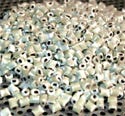May 13, 2008
Originally Published MPMN May 2008
BREAKTHROUGHS
Plastic Achieves Conductivity Comparable to Copper
|
In addition to being conductive, plastic-based ElectriPlast is moldable, malleable, and lightweight. |
While building a part for a satellite antenna, Thomas Aisenbrey scoured the globe for conductive plastics and was disappointed with what he found. “They’re more used for EMI, static dissipation, and RFI—real low-level stuff like that. I thought if we could figure out how to get [plastic] as conductive as copper, we’d have a lot of uses for it,” he says.
Drawing on doping experience dating back to his work in the semiconductor industry, Aisenbrey spent several years experimenting in his laboratory and produced a recipe for what he claims is the most conductive plastic on the planet. Dubbed ElectriPlast, the material boasts a conductance comparable to that of copper, says Aisenbrey, now the chief technology officer and general manager for Integral Technologies Inc., which produces ElectriPlast. The material is also 80% lighter than copper, in addition to being malleable and noncorrosive, he adds.
Consisting of small pellets of plastic-wrapped metal fibers, ElectriPlast is not resin-dependent. As a result, engineers can employ a version of the material that incorporates virtually any plastic. ElectriPlast can serve as a replacement for metal in many applications, potentially providing cost savings and design flexibility.
“We have more than 15,000 different recipes of ElectriPlast, ranging in conductance from silver, which is the best conductor on the planet, down to carbon, which is a very poor conductor,” Aisenbrey says. “There are uses for all of these.”
Moreover, the conductive plastic can be processed easily and is even moldable.
“We have a very advanced method for compounding our materials in a single pellet form so there’s no mixing involved for the end-user,” Aisenbrey says. “All you do is pour [the material] into your molding machine and mold with it like you would normal pellets.”
To date, Aisenbrey and Integral Technologies have identified more than 5000 uses for the material, several of which are for the medical industry. ElectriPlast-based defibrillator pads have the benefit of being able to deliver the required shock while being noncorrosive. The company also offers some recipes that are used in FDA-approved implants. Potential applications include pacemakers and shock-stimulation devices.
Integral Technologies Inc., Bellingham, WA
www.itkg.net
Copyright ©2008 Medical Product Manufacturing News
You May Also Like



